Deep snow storms and shallow blizzard memories
By Ray Hanania
 For some reason, many people think that the first big sow storm began in 1967. That’s usually when we start bringing out the “Snowfall Totals” when he start discussions about major Chicagoland blizzards.
For some reason, many people think that the first big sow storm began in 1967. That’s usually when we start bringing out the “Snowfall Totals” when he start discussions about major Chicagoland blizzards.
I am sure there were many more and heavier snowfalls before 1967, but that one is remembered as one of the worst we’ve had in years and usually tops the list as being the worst in terms of total snow fall.
Here’s the chart:
1967, Jan. 26-27: 23 inches
1999, Jan. 1 - 3: 21.6 inches
2011, Feb. 1-2: 21.2 inches
1979, Jan. 12-14: 20.3 inches
2015, Jan. 31-Feb. 1: 19.3 inches
The blizzards oftentimes have names. The 1967 blizzard is simply called “The 1967 Blizzard” because it is considered the “First one.” The 199 blizzard was a whopper. The 2011 blizzard is often referred to as the “Ground Hog’s Day Blizzard” or the “Lake Shore Drive Snow Jam.” And, the 1979 blizzard is remembered as the “Jane Byrne Blizzard” which helped plow her opponent Mayor Michael A. Bilandic out of office the following month.
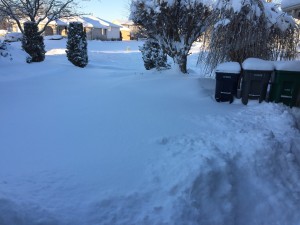
Suburbs. Snow blizzard Before plowing 2015
Chicago is located in the Midwest in the plaines near the Great Lakes. That all combines to create some whoppers of snow storms. Yet, Chicagoans continue to whine about the snow.
The biggest complaint always has to do with street cleaning. For some reason, residents of Chicagoland expect their governments not only to clear snow from the primary and secondary streets, but also from neighborhood streets.
Chicago has more than 4,000 miles of streets and 1,900 miles of allies. That’s a lot of streets to plow. But since when is the government responsible to clean neighborhood streets?
That entitlement began in 1979 when snow blanketed the Chicago area, the 4th worst Snow Storm in terms of total snowfall at one time. But it wasn’t because of the snowfall that people started to expect governments to not only clear the major roads and highways, but also the neighborhood streets. It was the promises made by the Bilandic administration, who paid a political crony and former deputy mayor Ken Sain, $90,000 to complete a 90-page report on how to remove
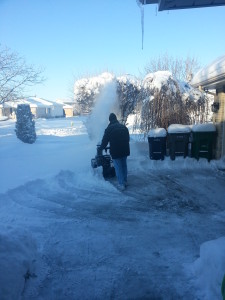
Suburbs. Snow blizzard being plowed 2015
snow in a major storm.
Back in 1979, $90,000 was a lot of money for one contract, and certainly a huge act of favoritism from Bilandic to Sain in terms of what was produced at $1,000 a double-spaced typed page.
No one expected the city or the suburbs to plow side streets or neighborhood streets in 1967. homeowners did that. But today, expectations grow with all of the political promises that are made.
Most suburban communities have it easier than Chicago and the older communities in the Western suburbs, like Cicero, which was built like an extension of Chicago. In the typical suburb today, side streets or neighborhood streets are wide enough to put four cars side-by-side comfortably. But in Chicago, the typical neighborhood street is wide enough for two parked cars and one lane down the center. That’s when one-way streets come in handy, of curse. Otherwise you have a bumper-to-bumper stand-off in the middle of the Chicago street.
That means most Chicago streets barely have enough room to drive a snow plow through.
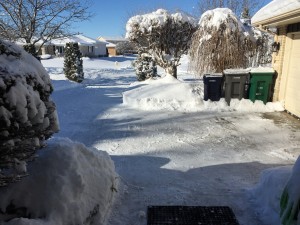
Suburbs. Snow blizzard after plowing 2015
I don’t like Chicago Mayor Rahm Emanuel, but not because he doesn’t know how to run a city. I dislike him because of his bias against its Arab citizens and his opposition to diversity. A record storm is going to be a challenge to clean up. Plus Chicagoans are weird. Yes, weird. The streets are public property, yet homeowners put “dibs” on parking spaces in front of their homes. When it snows, it eats up a lot of the available parking spaces to parking becomes a premium. They put furniture and junk in their “spots” in front of their homes to prevent people from taking them while they are away from their homes.
Worse is the conduct of the public. Government officials have to care for everyone but let’s face it, most homeowners only care about themselves. So when the snow covers their yards and sidewalks and driveways and their cars parked along the curb on the street or even in their driveways, instead of plowing or shoveling the snow onto their lawns, they push the snow into the street. It’s easier, especially when cleaning off the cars. And when a plow goes down a street, a lot of that snow that is plowed is pushed up and on top of the parked cars. And the snow packs. And, if the car hasn’t been moved or cleaned quickly, that snow hardens and ices up. Fast.
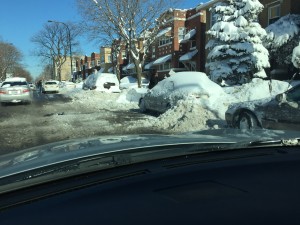
Cars covered in snow and neighbors pushing snow into the street, 2015. Snow blizzard
Have you driven by some driveways in the suburbs? Homeowners there have larger properties than homeowners in Chicago and yet the homeowners plow their snow off their driveways into the street.
Snow plowed off driveways into the streets become very icy and dangerous when cars drive through them. The snow creates small lumps that force the vehicles to swerve and get in accidents.
The toughest thing about the most recent snow is that the first 14 inches of snow was “snowman” snow meaning that it was thick, heavy and slightly wet making it great to build snowmen but a recipe for heart attacks to remove. That kind of snow requires a large snow blower. Snow blowers became very popular in the 1970s. The little Toro snowblower which would be too small to battle the storm we just experienced, cost more than $600 back then. Today, you can buy a powerhouse snow blower for $500, wide enough to clear 20 inches of snow wide and 20 inches of snow tall. That’s a lot of snow to remove at one time.
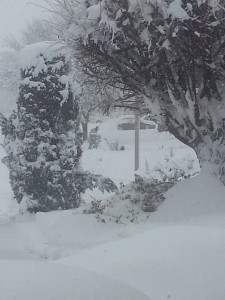
Helping the senior neighbors across the street.
But not everyone has a good snow blower and too many seniors find themselves imprisoned in their homes because they just can’t shovel on their own. So neighbors with snow plows need to be good neighbors and help clear off their driveways.
But stop whining, people. Snow is a part of Chicago. We know how to drive in it. We know how to remove it. And most importantly, we know how to be patient. There is no Computer App or Internet web page for snow removal. It’s going to be done int he same way we have been doing it for nearly half a century, since the news media began recording major snow storms in 1967.
When the snow falls for 24 hours that means no matter how many times
Lighten up people. Help your neighbors. Follow the rules. Be patient. Don’t push your snow into the street. Don’t complain about the municipal and city snow plow drivers who are out early clearing up the snow.
We’ll all get out of this alive, as we always do.
Managing Editor at Illinois News Network
Latest posts by admin (see all)
Related
 Blog Posts
Blog Posts





Deep snow storms and shallow blizzard memories
By Ray Hanania
I am sure there were many more and heavier snowfalls before 1967, but that one is remembered as one of the worst we’ve had in years and usually tops the list as being the worst in terms of total snow fall.
Here’s the chart:
1967, Jan. 26-27: 23 inches
1999, Jan. 1 - 3: 21.6 inches
2011, Feb. 1-2: 21.2 inches
1979, Jan. 12-14: 20.3 inches
2015, Jan. 31-Feb. 1: 19.3 inches
The blizzards oftentimes have names. The 1967 blizzard is simply called “The 1967 Blizzard” because it is considered the “First one.” The 199 blizzard was a whopper. The 2011 blizzard is often referred to as the “Ground Hog’s Day Blizzard” or the “Lake Shore Drive Snow Jam.” And, the 1979 blizzard is remembered as the “Jane Byrne Blizzard” which helped plow her opponent Mayor Michael A. Bilandic out of office the following month.
Suburbs. Snow blizzard Before plowing 2015
Chicago is located in the Midwest in the plaines near the Great Lakes. That all combines to create some whoppers of snow storms. Yet, Chicagoans continue to whine about the snow.
The biggest complaint always has to do with street cleaning. For some reason, residents of Chicagoland expect their governments not only to clear snow from the primary and secondary streets, but also from neighborhood streets.
Chicago has more than 4,000 miles of streets and 1,900 miles of allies. That’s a lot of streets to plow. But since when is the government responsible to clean neighborhood streets?
That entitlement began in 1979 when snow blanketed the Chicago area, the 4th worst Snow Storm in terms of total snowfall at one time. But it wasn’t because of the snowfall that people started to expect governments to not only clear the major roads and highways, but also the neighborhood streets. It was the promises made by the Bilandic administration, who paid a political crony and former deputy mayor Ken Sain, $90,000 to complete a 90-page report on how to remove
Suburbs. Snow blizzard being plowed 2015
snow in a major storm.
Back in 1979, $90,000 was a lot of money for one contract, and certainly a huge act of favoritism from Bilandic to Sain in terms of what was produced at $1,000 a double-spaced typed page.
No one expected the city or the suburbs to plow side streets or neighborhood streets in 1967. homeowners did that. But today, expectations grow with all of the political promises that are made.
Most suburban communities have it easier than Chicago and the older communities in the Western suburbs, like Cicero, which was built like an extension of Chicago. In the typical suburb today, side streets or neighborhood streets are wide enough to put four cars side-by-side comfortably. But in Chicago, the typical neighborhood street is wide enough for two parked cars and one lane down the center. That’s when one-way streets come in handy, of curse. Otherwise you have a bumper-to-bumper stand-off in the middle of the Chicago street.
That means most Chicago streets barely have enough room to drive a snow plow through.
Suburbs. Snow blizzard after plowing 2015
I don’t like Chicago Mayor Rahm Emanuel, but not because he doesn’t know how to run a city. I dislike him because of his bias against its Arab citizens and his opposition to diversity. A record storm is going to be a challenge to clean up. Plus Chicagoans are weird. Yes, weird. The streets are public property, yet homeowners put “dibs” on parking spaces in front of their homes. When it snows, it eats up a lot of the available parking spaces to parking becomes a premium. They put furniture and junk in their “spots” in front of their homes to prevent people from taking them while they are away from their homes.
Worse is the conduct of the public. Government officials have to care for everyone but let’s face it, most homeowners only care about themselves. So when the snow covers their yards and sidewalks and driveways and their cars parked along the curb on the street or even in their driveways, instead of plowing or shoveling the snow onto their lawns, they push the snow into the street. It’s easier, especially when cleaning off the cars. And when a plow goes down a street, a lot of that snow that is plowed is pushed up and on top of the parked cars. And the snow packs. And, if the car hasn’t been moved or cleaned quickly, that snow hardens and ices up. Fast.
Cars covered in snow and neighbors pushing snow into the street, 2015. Snow blizzard
Have you driven by some driveways in the suburbs? Homeowners there have larger properties than homeowners in Chicago and yet the homeowners plow their snow off their driveways into the street.
Snow plowed off driveways into the streets become very icy and dangerous when cars drive through them. The snow creates small lumps that force the vehicles to swerve and get in accidents.
The toughest thing about the most recent snow is that the first 14 inches of snow was “snowman” snow meaning that it was thick, heavy and slightly wet making it great to build snowmen but a recipe for heart attacks to remove. That kind of snow requires a large snow blower. Snow blowers became very popular in the 1970s. The little Toro snowblower which would be too small to battle the storm we just experienced, cost more than $600 back then. Today, you can buy a powerhouse snow blower for $500, wide enough to clear 20 inches of snow wide and 20 inches of snow tall. That’s a lot of snow to remove at one time.
Helping the senior neighbors across the street.
But not everyone has a good snow blower and too many seniors find themselves imprisoned in their homes because they just can’t shovel on their own. So neighbors with snow plows need to be good neighbors and help clear off their driveways.
But stop whining, people. Snow is a part of Chicago. We know how to drive in it. We know how to remove it. And most importantly, we know how to be patient. There is no Computer App or Internet web page for snow removal. It’s going to be done int he same way we have been doing it for nearly half a century, since the news media began recording major snow storms in 1967.
When the snow falls for 24 hours that means no matter how many times
Lighten up people. Help your neighbors. Follow the rules. Be patient. Don’t push your snow into the street. Don’t complain about the municipal and city snow plow drivers who are out early clearing up the snow.
We’ll all get out of this alive, as we always do.
Related articles
admin
Latest posts by admin (see all)
Share this:
Related